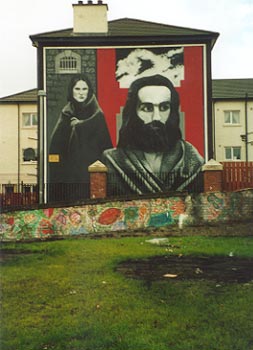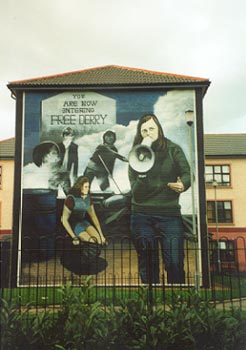Say the word "Belfast," and images come instantly to mind: pictures
of weapons, men in black hoods, hunger strikers, terror.
Belfast is eager to put those images behind it, and it may be
on the cusp of just that. Because today the people of Northern
Ireland have peace in their sights. Within days of September 11th,
a faction of the Irish Republican Army -- or IRA -- agreed to
decommission its arms. The move was the only bright spot in the
otherwise dark world news, and the first promising sign since
the 1994 ceasefire of an end to the sectarian war -- a war of
terrorism pitting Catholic against Protestant, Republican against
Loyalist, neighbor against neighbor.
In a world suddenly rocked by terrorism, Belfast offers its own
hard-won lessons to travelers willing to listen and look. Diane
Richard reports.
[pub sounds/music]
I'm in Belfast's majestic Crown Bar, sipping down a pint of Harp
in my own private snug. A snug is a booth surrounded by high wood
walls and a door. Inside, it feels like the perfect place to hatch
a plan or start an affair. But listening to the sounds of the
bar and inhaling the smoke, you realize that this is a public
place - a pub - and the walls let in as much as they keep out.
I've come to Belfast, ground zero of Northern Ireland's Troubles,
to learn about walls - what walls protect and what they divide.
[car sounds: wheels squeaking, acceleration]
My guide to The Troubles is Freddy. Freddy is a driver for Black
Taxi Tours, a Charon of sorts who ferries me into Britain's holy
hell. Our destination is West Belfast, the site of so many murders
and maimings by Ulster Unionists, primarily Protestants loyal
to the Union Jack. And by Irish Republicans, mainly Catholics,
fighting for a republic free from British rule.
Freddy: The main reason to come here is to see
the wall murals. The brightly colored paintings stretch two stories
high across entire building faces, and they document military
might and political martyrdom.
[car sounds]
In the Catholic neighborhood of Falls Road, murals dating back
to the '60s honor civilians killed with rubber bullets, and hunger
strikers who fasted and died for prison reform. Freddy stops in
front of one mural with a face I already know.
Freddy: This here is of the hunger strikers.
It's all the hunger strikers who died from 1981 on. Bobby Sands
is the most famous one - he's top left.
In the Protestant stronghold of Shankill Road, the wall murals
show more bravado. Here, portraits of men in black masks and holding
guns loom anonymous and menacing. But there are familiar faces
too. Princess Diana, for instance, elegant in her tiara, looks
out of place in this gritty, cheerless neighborhood.

These walls tell stories (patently partisan ones, to be sure.)
And locals seem to tolerate tourists who come to see them. Still,
Freddy's cautious not to stop too long at any one spot.
Freddy: Both sides like you to see the murals
and see their point of view.
[car sounds]
Sometimes, the walls of Northern Ireland have served darker purposes
too.
Before I arrived in Belfast, I spent a couple days in the ancient
city of Derry - Londonderry to Unionists. Derry is the site of
Bloody Sunday, where in 1972 British soldiers stood on the city
walls and gunned down 13 Catholic marchers. A monument stands
at the site, but walls tell that story best. Wall murals as big
as billboards pay tribute to the dead. Nearby, a wall in a Catholic
housing complex is still pitted with bullet holes.
[car sounds]
In Belfast, an ugly slab of industrial metal called the "Peace
Wall" cleaves the two warring sides. Cleaves them together and
cleaves them apart. Standing about 20 feet high, it has doors
that are locked at night to keep troublemakers on their own sides.
However, it's not high enough to stop the petrol bombs and sniper
fire that cascade almost nightly over the top.
Freddy: See that higher fence here? They used
to start throwing petrol bombs over the fence, both sides. ...
[glass sounds] See the scorched part over there? What kind of
bomb did you say? Petrol bomb. You've seen them, I'm sure. No,
thankfully not. They get a normal milk bottle and they fill it
half to three quarters with petrol, ... once it hits it, boom,
it explodes. That's both sides that be throwing it. They sometimes
in the past got a set of step ladders to go up and they'd shoot
at each other, in the past.
So what you're saying that despite the Peace Wall, there is
no peace and no wall is going to deter... There is a certain
amount of peace. There's no army on the streets no more. There
is a fair amount of peace. But what I'm saying is there is still
things going on that aren't basically reported or broadcast
on the news.
After an hour, Freddy dropped me off at my hotel. I paid him
about 15 bucks for the tour, and he told me the names of a couple
places to hear "fiddledeedee," or Irish music. Then he looked
at me seriously. He said he'd give the peace process another five
years to take hold. Then he shrugged.
Freddy: I hope there'll be peace in Ireland.
But I'm very skeptical about it, very skeptical about it. About
peace? Yah, yah. I lost a friend in it. That's all I'll say about
that.
In the morning, I woke up to bad news.
Now also in Belfast last night a teenager was killed by a pipe
bomb. The young man who died was the author of his own destruction.
Senior police officers said this morning
So here I sit within the walls of my snug at the pub, shielded
from others' eyes, but united by air and sound. And my tour of
West Belfast has left me thinking about our own war on terrorism.
I'm thinking that the walls we are constructing for ourselves,
symbolic or real, offer no guarantees. They can be surmounted.
They can be penetrated. And they can be painted to honor the dead.
Only diplomacy offers a hope for lasting peace.
In Belfast, I'm Diane Richard for the Savvy Traveler.






